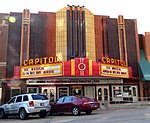Snake Alley (Burlington, Iowa)
Burlington, IowaIndividually listed contributing properties to historic districts on the National Register in IowaNRHP infobox with nocatNational Register of Historic Places in Des Moines County, IowaRoads on the National Register of Historic Places in Iowa ... and 3 more
Streets in IowaTourist attractions in Des Moines County, IowaTransportation in Des Moines County, Iowa

Snake Alley is a street located in Burlington, Iowa, which was built in 1894. In 2017, Ripley's Believe It or Not! recognized the street as "Unbelievably Crooked" and the #1 Odd Spot in their Odd Spots Across America Campaign.
Excerpt from the Wikipedia article Snake Alley (Burlington, Iowa) (License: CC BY-SA 3.0, Authors, Images).Snake Alley (Burlington, Iowa)
Snake Alley, Burlington
Geographical coordinates (GPS) Address Nearby Places Show on map
Geographical coordinates (GPS)
| Latitude | Longitude |
|---|---|
| N 40.81196111 ° | E -91.10569722 ° |
Address
Snake Alley
Snake Alley
52601 Burlington
Iowa, United States
Open on Google Maps










